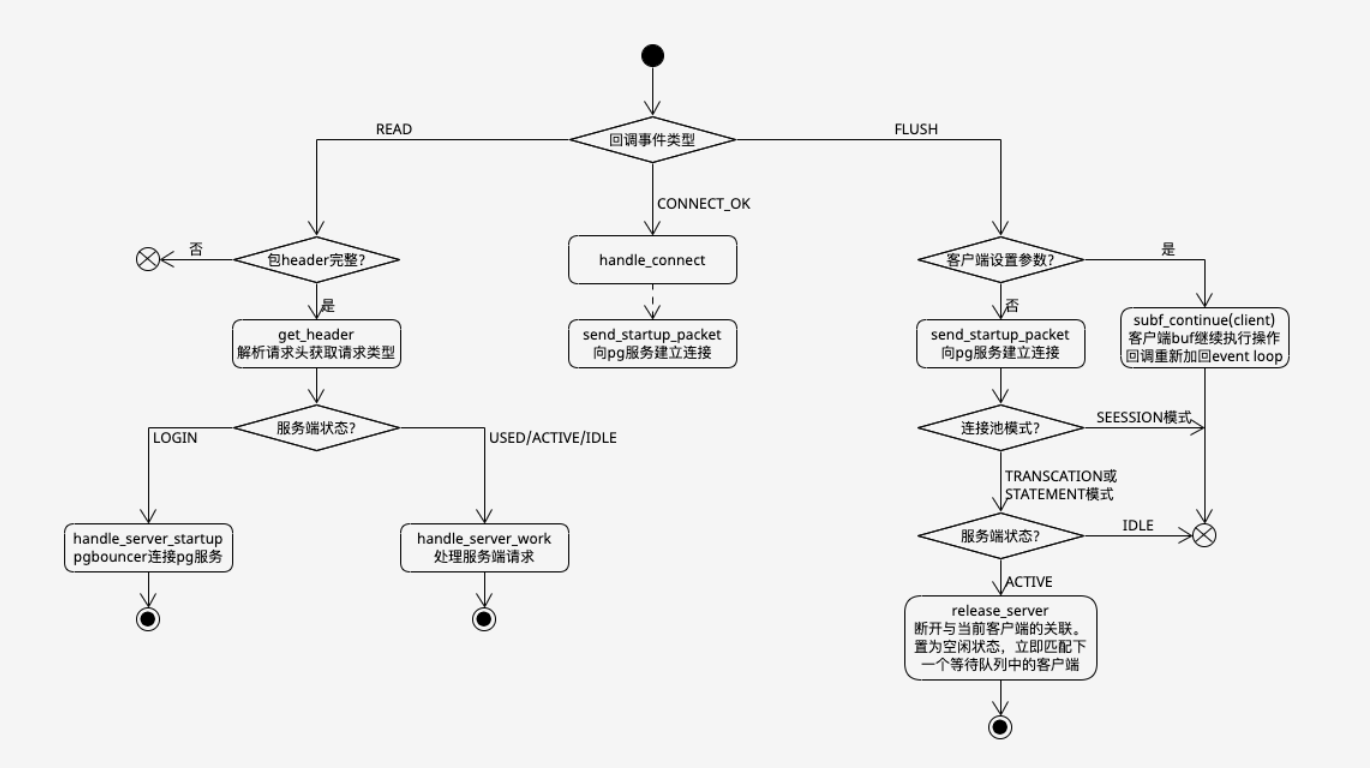背景
pgbouncer是一个PostgreSQL的轻量级线程池,支持客户端多种连接方式。
本地编译部署
# 依赖安装
brew install autoconf automake libtool
# 编译
sh autogen.sh
./configure --enable-debug --prefix=/usr/local --with-openssl=/usr/local/opt/openssl
make clean; make
# 部署到/usr/local/bin
make install
使用方式
连接用户数据库
使用pgbouncer需要配置增加配置文件:
; pgbouncer.ini
[databases]
db1 = host=localhost port=5432 dbname=postgres
[pgbouncer]
listen_port=6432
listen_addr=localhost
auth_type=md5
auth_file=userlist.txt
logfile=pgbouncer.log
pidfile=pgbouncer.pid
admin_users=pgbouncer
; session,transaction,statement
pool_mode=transaction
userlist.txt配置如下:
"postgres" "1"
"pgbouncer" "pgbouncer"
执行指令为: pgbouncer pgbouncer.ini [-dvuR],具体可查阅官方文档。
在上述配置的场景下,直连postgres和通过pgbouncer代理连接的命令分别为:
# 直连postgres
psql -U postgres -d postgres -h localhost -p 5432
# 通过pgbouncer连接
psql -U postgres -d db1 -h localhost -p 6432
连接pgbouncer后台
pgbouncer本身会提供一个假的数据库,可以查看pgbouncer整体的状态,连接方式是按上面的配置文件配置admin_users。
在上述配置的场景下,连接pgbouncer后台假数据库的方式为:
~ $ psql -h 127.0.0.1 -p 6432 -U pgbouncer -d pgbouncer
pgbouncer=# show mem;
name | size | used | free | memtotal
--------------+------+------+------+----------
user_cache | 2312 | 3 | 47 | 115600
db_cache | 216 | 2 | 73 | 16200
pool_cache | 552 | 1 | 49 | 27600
server_cache | 608 | 0 | 0 | 0
client_cache | 608 | 1 | 49 | 30400
iobuf_cache | 4112 | 1 | 49 | 205600
区分连接pgbouncer密码与连接数据库密码
需要区分密码的话,需要在databases的配置中指定用户名和密码,这样的话pgbouncer连接pg服务端时,就只会按照databases中的配置来。
; pgbouncer.ini
[databases]
db1 = host=localhost port=5432 dbname=postgres user=postgres password=diffpw
pgbouncer连接池复用等级
pgbouncer连接池的复用等级有SESSION、TRANSACTION、STATEMENT。
SESSION模式支持postgres所有特性,连接池的连接会被客户端一直占有直到客户端退出TRANSACTION模式下,当客户端有请求时,从连接池取出连接提供给客户端执行,执行完成之后放回连接池,不被客户端占有。支持事务,但无法支持一些全局变量的设置STATEMENT模式下,功能与TRANSACTION模式类似,但是不支持事务,只支持单语句提交
SESSION与TRANSACTION在postgres上的特性支持对比:
| Feature | Session pooling | Transaction pooling |
|---|---|---|
| Startup parameters | Yes | Yes |
| SET/RESET | Yes | Never |
| LISTEN/NOTIFY | Yes | Never |
| WITHOUT HOLD CURSOR | Yes | Yes |
| WITH HOLD CURSOR | Yes | Never |
| Protocol-level prepared plans | Yes | No |
| PREPARE / DEALLOCATE | Yes | Never |
| ON COMMIT DROP temp tables | Yes | Yes |
| PRESERVE/DELETE ROWS temp tables | Yes | Never |
| Cached plan reset | Yes | Yes |
| LOAD statement | Yes | Never |
| Session-level advisory locks | Yes | Never |
代码逻辑
一些重要的结构体
struct List {
/** Pointer to next node or head. */
struct List *next;
/** Pointer to previous node or head. */
struct List *prev;
};
/**
* Header structure for StatList.
*/
struct StatList {
/** Actual list head */
struct List head;
/** Count of objects currently in list */
int cur_count;
};
/*
* Store for pre-initialized objects of one type.
*/
struct Slab {
struct List head;
struct StatList freelist;
struct StatList fraglist;
char name[32];
unsigned final_size;
unsigned total_count;
slab_init_fn init_func;
CxMem *cx;
};
/*
* Stream Buffer.
*
* Stream is divided to packets. On each packet start
* protocol handler is called that decides what to do.
*/
struct SBuf {
struct event ev; /* libevent handle */
uint8_t wait_type; /* track wait state */
uint8_t pkt_action; /* method for handling current pkt */
uint8_t tls_state; /* progress of tls */
int sock; /* fd for this socket */
unsigned pkt_remain; /* total packet length remaining */
sbuf_cb_t proto_cb; /* protocol callback */
SBuf *dst; /* target SBuf for current packet */
IOBuf *io; /* data buffer, lazily allocated */
const SBufIO *ops; /* normal vs. TLS */
struct tls *tls; /* TLS context */
const char *tls_host; /* target hostname */
};
struct ListenSocket {
struct List node;
int fd;
bool active;
struct event ev;
PgAddr addr;
};
/*
* parsed packet header, plus whatever data is
* available in SBuf for this packet.
*
* if (pkt->len == mbuf_avail(&pkt->data))
* packet is fully in buffer
*
* get_header() points pkt->data.pos after header.
* to packet body.
*/
struct PktHdr {
unsigned type;
unsigned len;
struct MBuf data;
};
const struct CfLookup pool_mode_map[] = {
{ "session", POOL_SESSION },
{ "transaction", POOL_TX },
{ "statement", POOL_STMT },
{ NULL }
};
框架
pgbouncer是通过libevent实现的reactor框架,向event_loop中添加或删除socket的回调函数,通过回调函数处理数据。
pgbouncer起了一个代理的效果,它对与用户的请求交互通过client socket,与pg server交互通过server socket。client socket会模拟真实的pg server,返回给用户自己伪造的返回包或者透传server socket的返回包。

连接池
pgbouncer连接池实例中有5个服务端链表,这里维护的都是与pg server的真实连接,通过链表之间的移动代表一个真实连接在连接池中的状态。
struct StatList active_server_list;
struct StatList idle_server_list;
struct StatList used_server_list;
struct StatList tested_server_list;
struct StatList new_server_list;
根据连接池模式(session/transaction/statement)设置的不同,链表之间的移动逻辑也对应有改变。例如:
session模式下,当客户端查询完成时,server的连接会保持在active_server_list中。- 在
transaction和statement模式中,server的连接会回到idle_server_list中,等待其他客户端的调用。在这种情况下,实际上用户是不持有pg server的连接的,但是由于pgbouncer fake server的存在,让他误以为自己依旧占有连接,并可以继续进行sql操作。因此这两种模式能高效利用与pg server的连接,提高并发量。
重要函数
数据接受与处理回调函数(sbuf_main_loop)

客户端回调函数(client_proto)
.png)
服务端回调函数(server_proto)

调用流程比较
普通pg server连接流程

pgbouncer首次连接及查询流程(transaction mode)
